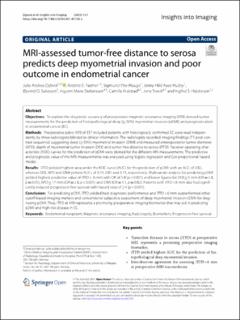| dc.contributor.author | Dybvik, Julie Andrea | |
| dc.contributor.author | Fasmer, Kristine Eldevik | |
| dc.contributor.author | Ytre-Hauge, Sigmund | |
| dc.contributor.author | Husby, Jenny Hild Aase | |
| dc.contributor.author | Salvesen, Øyvind | |
| dc.contributor.author | Stefansson, Ingunn Marie | |
| dc.contributor.author | Krakstad, Camilla | |
| dc.contributor.author | Trovik, Jone | |
| dc.contributor.author | Haldorsen, Ingfrid S. | |
| dc.date.accessioned | 2022-06-27T08:56:26Z | |
| dc.date.available | 2022-06-27T08:56:26Z | |
| dc.date.created | 2022-04-11T13:43:31Z | |
| dc.date.issued | 2022 | |
| dc.identifier.issn | 1869-4101 | |
| dc.identifier.uri | https://hdl.handle.net/11250/3001012 | |
| dc.description.abstract | Objectives
To explore the diagnostic accuracy of preoperative magnetic resonance imaging (MRI)-derived tumor measurements for the prediction of histopathological deep (≥ 50%) myometrial invasion (pDMI) and prognostication in endometrial cancer (EC).
Methods
Preoperative pelvic MRI of 357 included patients with histologically confirmed EC were read independently by three radiologists blinded to clinical information. The radiologists recorded imaging findings (T1 post-contrast sequence) suggesting deep (≥ 50%) myometrial invasion (iDMI) and measured anteroposterior tumor diameter (APD), depth of myometrial tumor invasion (DOI) and tumor-free distance to serosa (iTFD). Receiver operating characteristic (ROC) curves for the prediction of pDMI were plotted for the different MRI measurements. The predictive and prognostic value of the MRI measurements was analyzed using logistic regression and Cox proportional hazard model.
Results
iTFD yielded highest area under the ROC curve (AUC) for the prediction of pDMI with an AUC of 0.82, whereas DOI, APD and iDMI yielded AUCs of 0.74, 0.81 and 0.74, respectively. Multivariate analysis for predicting pDMI yielded highest predictive value of iTFD < 6 mm with OR of 5.8 (p < 0.001) and lower figures for DOI ≥ 5 mm (OR = 2.8, p = 0.01), APD ≥ 17 mm (OR = 2.8, p < 0.001) and iDMI (OR = 1.1, p = 0.82). Patients with iTFD < 6 mm also had significantly reduced progression-free survival with hazard ratio of 2.4 (p < 0.001).
Conclusion
For predicting pDMI, iTFD yielded best diagnostic performance and iTFD < 6 mm outperformed other cutoff-based imaging markers and conventional subjective assessment of deep myometrial invasion (iDMI) for diagnosing pDMI. Thus, iTFD at MRI represents a promising preoperative imaging biomarker that may aid in predicting pDMI and high-risk disease in EC. | en_US |
| dc.language.iso | eng | en_US |
| dc.publisher | Springer | en_US |
| dc.rights | Navngivelse 4.0 Internasjonal | * |
| dc.rights.uri | http://creativecommons.org/licenses/by/4.0/deed.no | * |
| dc.title | MRI-assessed tumor-free distance to serosa predicts deep myometrial invasion and poor outcome in endometrial cancer | en_US |
| dc.type | Journal article | en_US |
| dc.type | Peer reviewed | en_US |
| dc.description.version | publishedVersion | en_US |
| dc.rights.holder | Copyright The Author(s) 2021 | en_US |
| dc.source.articlenumber | 1 | en_US |
| cristin.ispublished | true | |
| cristin.fulltext | original | |
| cristin.qualitycode | 1 | |
| dc.identifier.doi | 10.1186/s13244-021-01133-z | |
| dc.identifier.cristin | 2016732 | |
| dc.source.journal | Insight into Imaging | en_US |
| dc.identifier.citation | Insight into Imaging. 2022, 13, 1. | en_US |
| dc.source.volume | 13 | en_US |

